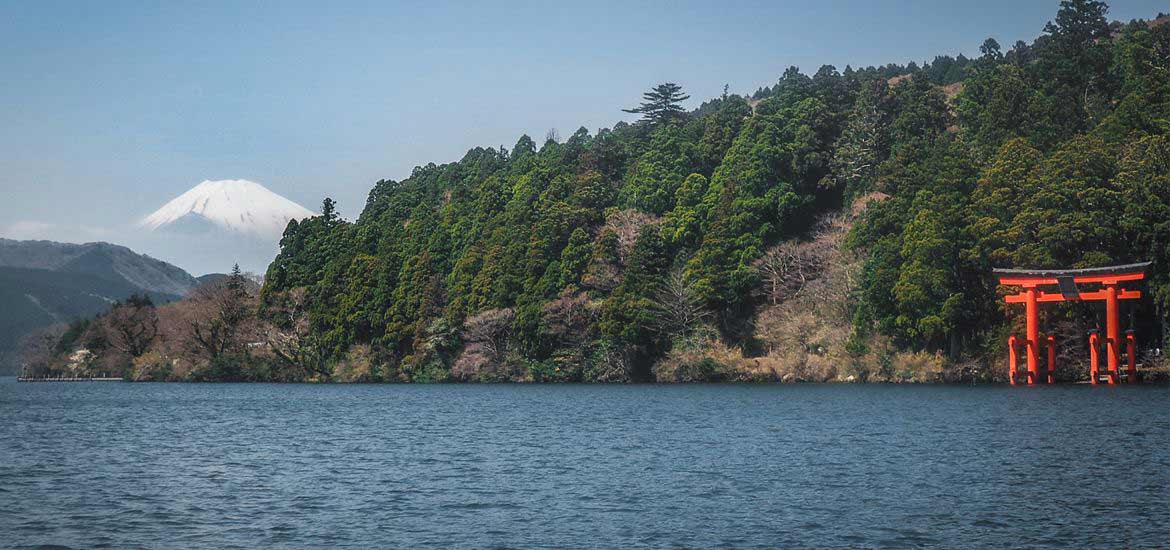MORE JAPAN TRAVEL:
HOW TO SPEND 10 DAYS IN JAPAN | TOKYO | KYOTO | NARA | KOBE | HIMEJI | OSAKA | SENDAI | MATSUSHIMA

If you’re traveling to Tokyo, it’s common to reserve a day for a getaway and explore regions nearby: Nikko, Kamakura and Hakone are popular picks.
Hakone is the local’s choice for hot spring resorts and, if you’re lucky, a view of Mt. Fuji over stunning Lake Ashi. Go here if you’re interested in experiencing a traditional ryokan (inn), onsen (hot springs) or want to try your luck at Fuji-sightings.
This tiny mountain town is also well known for Owakudani, a volcanic valley spewing sulfurous gasses, accessible at the top of a ropeway. And the whole region, from the town to the lake to the sulfurous cone, is an ancient caldera! Where the western edge collapsed is the access point, including the Hakone-Yumoto station you will arrive in from Tokyo.
This can be done in a day trip with a return to Tokyo, but I would recommend staying the evening to experience a ryokan, if it’s in your budget.
Transportation

There’s no direct train into the towns of Moto-Hakone and Hakone-machi that flank the lake, so your options for arrival are a bus from the station or, the more popular choice for sightseeing, the Hakone Course. Grab a Hakone Freepass that allows for access to the transportation circuit, and drop off your bags with the carry service located in the station so they will be waiting for you at your resort. This was effortless and inexpensive to do. Lugging large bags on the trains and cable cars would have been a nightmare.
1) Hakone-Tozan train from the train station to Gora, an awesome track that switchbacks up the volcano’s incline
2) A short cable car ride from Gora to Sounzan
3) A ropeway from Sounzan to Owakudani, the volcanic center
4) A ropeway from Owakudani to Togendai-ko, a waiting station
5) The Hakone Sightseeing Cruise, a veritable pirate ship that crosses Lake Ashi to stop at Hakone-machi and Moto-Hakone, in that order.
6) From here, you can explore the area before checking into your inn, or grab a bus back to the Hakone-yumoto station.
Owakudani
This active volcanic valley is where you can peer at the yellow plumes of sulfur vents that power the region’s famous hot springs. The best view is from the ropeway on the way in, which dangles you directly above it, but the lookout on top is interesting as well.

If you’re at all interested in what you’re standing on, you should check out the inexpensive GeoMuseum, an informative walkthrough of the region bolstered with English descriptions of the volcano’s formation and how the sulfur activity is harnessed for the hot springs. This is where I learned the word 火山, kazan, for volcano – very literal kanji for “fire mountain.”
The best snack at the top is without a doubt the famous black eggs (kurotamago), boiled in the spring water until the shell turns black. Eating an egg is said to add seven years to your life—but don’t eat many more because, you know, cholesterol. They came in hearty packs of five, so rather than waste food my husband and I sat, salted and stuffed our faces with more boiled eggs than I’ve eaten in the last two years of my life. Hello, longevity?

On a clear day, you’ll see Mt. Fuji in all its glory from the top. While we were exploring, there was a buzz in the crowds and attempts at photos as we saw a part of her snowy caps through the parting clouds. On the way down the ropeway to Togendai-ko, more magic was happening. And by the time we were boarding the ships, I got a real treat.
Lake Ashi
Boom. Fuji! I was so excited we lucked out on the weather for this view.


Moto-Hakone
Our day continued after departing the boat at its second stop. We grabbed lunch at Shinsho Soba to try the area’s traditional noodle dish. They’ll hand you a limited English menu on entering, but if you can, get the regular menu or just order the “Tenseiro:” Delectably-flavored traditional noodles plus fresh-fried tempura.


Nearby Hakone Shrine is well worth a walk up mossy steps under a canopy of cedars. Follow the instructions to cleanse your hands in the purification fountain depicting the shrine’s honored spirit, a nine-headed dragon said to live in the lake. At the bottom of the shrine at the lake’s edge is a beautiful crimson gate. I didn’t feel like waiting in line for the picture, but if the crowds aren’t too busy it’s a beautiful photo opp.


Old Tokkaido Highway
As hikers and history buffs, our next stop had to be walking a preserved section of the Old Tokkaido Highway. This once-important trade route once connected Edo to the Hakone Checkpoint, and was notorious for its difficulty. Our modern section was a breeze, and a scenic escape to decompress from the crowds earlier in the day and the glamour of Tokyo. As we trod on the same stones as visiting dignitaries and tradesmen in 1618, we were completely alone. Educational signs and markers with English led the way.





We stopped in Amazake-chaya tea house about a mile in, a traditional 1600s rest house serving refreshments to refuel. The interior was dark, soothing and warmed with the thick smell of charcoal smoke. We sat at communal tables and I talked in broken Japanese while sipping amazake, a hot, sweet rice drink. If you continue down the road for a few more minutes, you’ll arrive at a bus stop that will take you back to town. We didn’t have time for the full walk into Hatajuku.

Hakone Chekpoint
From Moto-Hakone, we walked alongside the lake and then on the other side of the street through the Ancient Cedar Avenue. After our walk on the section of the cedar-linked Tokkaido Highway, this was beautiful but not as serene. Hakone Checkpoint was a brief but interesting reconstruction of the Edo-era military presence where travelers were scrutinized for arms and women were detained in attempts to flee their captivity in the capital. I enjoyed the view of Lake Ashi from the watchtower.


Ryokan
We stayed at Yuugiriso, a mid-range resort off a convenient street in Hakone. This was my second ryokan stay, and it was just as lovably confusing and awkward as the first. The traditional Japanese inns are typified by some luxuries not common in Western resort life: The requirement to wear provided (and always too-small) slippers; a multi-course in-room meal prepared in rounds for you while you kneel at the table; a man that comes in after dinner to move said table and prepare your bedding on the tatami mats; and gender-separated hot spring baths, where you are required to go completely naked, and emerge wrapped in a yukata—you know how to wrap a yukata, right?


We had fun and I tried my best to converse in Japanese with our doting room maids. The meal was outstanding, but we opted out of trying the separated hot springs, going instead together in the private family bath. I know I made it sound somewhat unapproachable, but it was the most memorable place we stayed and great exposure to different customs. We got breakfast in a common area the next morning, too, and marveled at the picked fish and boiled veggies alongside a yukata-clad German couple.




